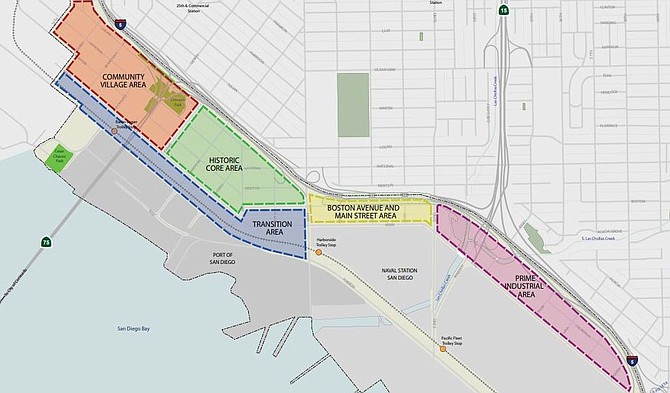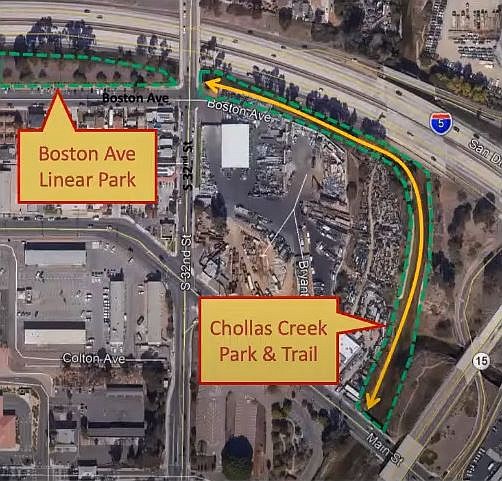 Facebook
Facebook
 X
X
 Instagram
Instagram
 TikTok
TikTok
 Youtube
Youtube

Barrio Logan has fewer residents today than in 2010, a reverse trend from most of San Diego. But as its new community plan takes shape, chock full of improvements from parks and bikeway links to many more live-work units, that too is likely to change.
Its location just south of downtown and along the bay is a draw.
"I know a lot of people are starting to see this as a desirable area to move into," planning commissioner Vicki Granowitz said last week at a workshop on the Community Plan update, worrying that gentrification is pushing at the close-knit Hispanic community.
Senior planner Michael Prinz declined to speculate on the SANDAG data showing a decrease of 600 people but said the slump occurred despite a slight increase in the number of units.
Under the update to the 2013 community plan, overall housing capacity will increase by 50 percent over the original 1978 plan. It will allow 29 dwelling units per acre in the neighborhood commercial area, and 14 units per acre in the Boston Ave. residential area.
A transition zone will finally separate homes from industry. A village core will be established. And the dilapidated sidewalks and paths to nowhere is on the table. New suggestions by the community would expand bike access beyond what the 2013 plan recommended.
They include traffic calming and bicycling improvements on National Ave. and Main St., freeway access at 28th St., multimodal updates along Boston Ave., a linear park and roundabouts.

The changes sought spring from a long history of clashing uses; homes and industry packed together, zoning unique to the working waterfront of Barrio Logan, which is chopped up by freeways.
"Pedestrian infrastructure in the neighborhood is virtually non-existent," said commissioner Matthew Boomhower. "The sidewalks are abysmal. There's a serious lack of trees."
It's not because people don't walk and bike, he said. Residents walk over to the mercado on Cesar Chavez, and investment there should be part of the plan - "it's been neglected over the years by the city" and will need to be reconstructed.
Among the suggestions being evaluated by mobility staff are two lanes with roundabouts on Cesar Chavez Parkway, bike facilities along Main St., and connections to Chollas Creek and the Bayshore Bikeway.
Much of the recreation focus has been on Boston Ave. Linear Park, a three-acre, 1/3 mile long strip of green that can serve as a noise buffer against I-5. Connections between it and Chollas Creek Park and Trail, which adds another two acres and 1/4 mile of outdoor space.
Another neighborhood improvement, which the city has been evaluating as the plan goes forward, is a list of 60 prohibited uses specified in an agreement between the community and shipbuilding and maritime interests.
It covers 65 acres where new industrial uses won't be allowed (previous ones are grandfathered in). Prinz said those uses are so specific, they don't have existing citywide zones that clearly line up with each one. So a community plan overlay zone will be applied.
It would prohibit residential, childcare and nursing facilities in the transition zone or any use requiring a hazardous materials permit.
Julie Corrales, who lives in Barrio Logan and works with the Environmental Health Coalition, said they appreciate the collaboration of the shipbuilding industry.
She has witnessed small changes in demographics in the past few years. "One of the constant things we hear from our base is the issue of rising rents. Even our own members on the community planning group have had to move. They've been pushed out and had to leave their seat on the board and go further east" to find affordable housing.
Barrio Logan is a working class community, and families are being displaced or forced to live together in smaller spaces, she added. "When they do leave, singles and couples move in.
I hope the planning commission can get behind any methods and tactics the community puts forward via the plan to address some of that."


Barrio Logan has fewer residents today than in 2010, a reverse trend from most of San Diego. But as its new community plan takes shape, chock full of improvements from parks and bikeway links to many more live-work units, that too is likely to change.
Its location just south of downtown and along the bay is a draw.
"I know a lot of people are starting to see this as a desirable area to move into," planning commissioner Vicki Granowitz said last week at a workshop on the Community Plan update, worrying that gentrification is pushing at the close-knit Hispanic community.
Senior planner Michael Prinz declined to speculate on the SANDAG data showing a decrease of 600 people but said the slump occurred despite a slight increase in the number of units.
Under the update to the 2013 community plan, overall housing capacity will increase by 50 percent over the original 1978 plan. It will allow 29 dwelling units per acre in the neighborhood commercial area, and 14 units per acre in the Boston Ave. residential area.
A transition zone will finally separate homes from industry. A village core will be established. And the dilapidated sidewalks and paths to nowhere is on the table. New suggestions by the community would expand bike access beyond what the 2013 plan recommended.
They include traffic calming and bicycling improvements on National Ave. and Main St., freeway access at 28th St., multimodal updates along Boston Ave., a linear park and roundabouts.

The changes sought spring from a long history of clashing uses; homes and industry packed together, zoning unique to the working waterfront of Barrio Logan, which is chopped up by freeways.
"Pedestrian infrastructure in the neighborhood is virtually non-existent," said commissioner Matthew Boomhower. "The sidewalks are abysmal. There's a serious lack of trees."
It's not because people don't walk and bike, he said. Residents walk over to the mercado on Cesar Chavez, and investment there should be part of the plan - "it's been neglected over the years by the city" and will need to be reconstructed.
Among the suggestions being evaluated by mobility staff are two lanes with roundabouts on Cesar Chavez Parkway, bike facilities along Main St., and connections to Chollas Creek and the Bayshore Bikeway.
Much of the recreation focus has been on Boston Ave. Linear Park, a three-acre, 1/3 mile long strip of green that can serve as a noise buffer against I-5. Connections between it and Chollas Creek Park and Trail, which adds another two acres and 1/4 mile of outdoor space.
Another neighborhood improvement, which the city has been evaluating as the plan goes forward, is a list of 60 prohibited uses specified in an agreement between the community and shipbuilding and maritime interests.
It covers 65 acres where new industrial uses won't be allowed (previous ones are grandfathered in). Prinz said those uses are so specific, they don't have existing citywide zones that clearly line up with each one. So a community plan overlay zone will be applied.
It would prohibit residential, childcare and nursing facilities in the transition zone or any use requiring a hazardous materials permit.
Julie Corrales, who lives in Barrio Logan and works with the Environmental Health Coalition, said they appreciate the collaboration of the shipbuilding industry.
She has witnessed small changes in demographics in the past few years. "One of the constant things we hear from our base is the issue of rising rents. Even our own members on the community planning group have had to move. They've been pushed out and had to leave their seat on the board and go further east" to find affordable housing.
Barrio Logan is a working class community, and families are being displaced or forced to live together in smaller spaces, she added. "When they do leave, singles and couples move in.
I hope the planning commission can get behind any methods and tactics the community puts forward via the plan to address some of that."
Comments